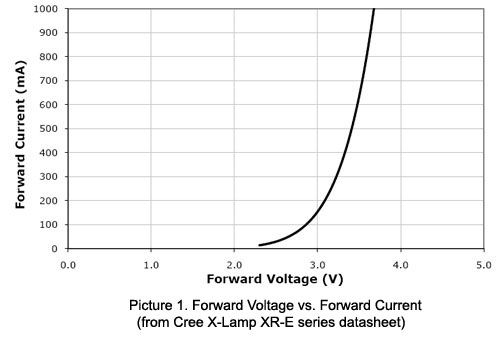MegaSack DRAW - This year's winner is user - rgwb
We will be in touch
Why when I test an LED with my multi meter in ohm mode does the led glow a bit but the meter still shows the 1 for over-range?
What are you expecting it to do? You can't really doing any kind of test on an led with a multimeter in ohm mode. If it has a diode test mode then it is handy for finding polarity. The led glowing is just because the meter is providing some power.
You need enough voltage to exceed the forward voltage of the LED.
On the ohm setting, your multimeter won't do that:
It does glow though, so current is flowing.
Anyway, one does not glow so it's presumably the one that has failed. Seems rather hard to find a replacement though.
Wouldn't rely on that logic. There are many and varied LED setups and the fact that your meter exceeds the forward bias on one doesn't mean it'll do the same on the next.
Shove a battery on it? (Just not for long.)
Led's or Light Emitting Diodes are, funnily enough diodes! This means that broadly speaking, they block reverse current flow (cathode to anode) but allow forward current flow (anode to cathode). However, like most diodes, they have a very non linear resistance with forward voltage:
And the exact shape of that curve depends upon the exact chemistry of the led, which varries with things like colour, and power output amongst other things.
Now, your multimeter, in order to work out the resistance of a component puts out a voltage, and measures how much current flows. As V=IR, say it put out 1 volt and measures 1 amp, then the resistance of the component being tested is 1 ohm.
So, when you connect your LED, if you connect it backwards, it should read off scale high (no current flow) but connected forwards, it'll depend upon the exact voltage the meter can apply (which varies between meters).
Most meters have a specific diode test setting, designed to display the forward voltage of the diode being tested.
PS, don't just shove a battery on it! You'll blow the led up. All leds need either a constant current driver, or a series resistor to limit current flow, as should be obvious from the graph i just posted!
Well I replaced the one that didn't glow with a new 5mm one from Maplin and it works, and the two are the same brightness.
But there's something I still don't understand. The voltage I measured at the supply is 10v AC near enough. There's a rectifier, after which the voltage is about 9ish vdc. The series resistor for the two LEDs is 92 ohms. So the current is therefore approx 100mA. That makes the power about 0.9W.
But it's clearly not that bright, and the LED I bought is only rated 100mW and is the same size and brightness. So it's clearly the right component. Have I got my calculations wrong?
Depends on the forward voltage of the LEDs, so the whole 9v won't be dropped across the resistor, so that will change the amount of current actually drawn.
Then, the power in the LEDs will only be the forward voltage of the LED multiplied by the current.
So, if Vf for the LED is 1v then 8v will be dropped across the resistor. This will give a current through the resistor of 8v/92 ohms which is approx 85mA. So, the power in the LED is then Vf multiplied by the current, so 1 * 85mA, so would be approx 85mW.
D'oh.. yes of course! Basic physics fail!
Test it with the diode test function.

